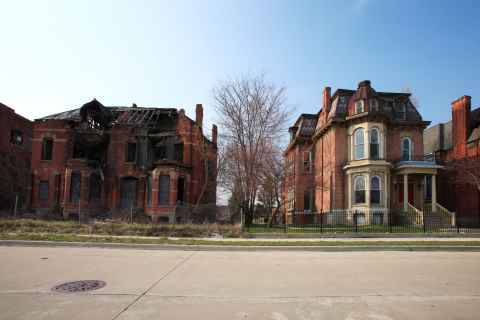Depending upon one’s political persuasion, one is often quick to blame either parasitic, bureaucratic government or greedy, profit-motivated capitalists for the problems of the lower and working classes. However, in Detroit’s housing dispossession crisis, both of these factors come together to form a cause-and-effect relationship that cuts hardworking families out of the picture.
First, disinterested government attacks working and working poor families by being unresponsive to economic change.  In fact, when the Great Recession hit, sending the city on the path toward bankruptcy, most property taxes did not sink proportionately to the decline in property value, leaving 65% of homeowners (from 2009-15) on the hook for far more than they could afford (VICE News, 2017). Then, making matters worse, the city failed to perform the necessary outreach in order to notify struggling residents of a property tax exemption, leading only 10%-15% of those eligible to fill out the required paperwork (Stegbauer, 2019). This combination of out-of-touch and overly bureaucratic government, combined with an already economically marginalized population, regularly leads Detroit - 7% of Michigan’s population - to be home to a supermajority of the state’s tax foreclosures (Paffendorf, 2019).
In fact, when the Great Recession hit, sending the city on the path toward bankruptcy, most property taxes did not sink proportionately to the decline in property value, leaving 65% of homeowners (from 2009-15) on the hook for far more than they could afford (VICE News, 2017). Then, making matters worse, the city failed to perform the necessary outreach in order to notify struggling residents of a property tax exemption, leading only 10%-15% of those eligible to fill out the required paperwork (Stegbauer, 2019). This combination of out-of-touch and overly bureaucratic government, combined with an already economically marginalized population, regularly leads Detroit - 7% of Michigan’s population - to be home to a supermajority of the state’s tax foreclosures (Paffendorf, 2019).
As a result of this government malpractice, thousands of Detroit properties become foreclosed upon every year, with the county taking ownership after three years’ delinquency on property taxes (VICE News, 2017). This has created a burgeoning market for opportunistic land speculators, whose nose for cheap properties leads them to Detroit time and again. Twice a year, the Wayne County Treasurer’s Office auctions all of the homes that have been foreclosed upon in the previous twelve months, leading many profit-seeking new landlords to accumulate numerous occupied homes. This effectively turns former owners into renters and produces one of two outcomes. For one, the land speculator can earn his or her investment back and begin turning a considerable profit within as little as months. However, the indignity of being a renter in one’s own home can also lead many to a second conclusion: moving elsewhere. In turn, the latter response leads speculators to either acquire a new tenant off of whom to turn a profit or allow the property to become blighted as it remains uninhabited for long periods of time.
Across all scenarios, though, Detroit’s lower and working class homeowners lose power and leverage over their own neighborhoods, either forcing them out of the places they call home or to remain in a city controlled by outsiders who have no incentive to retain community continuity or beauty. In the Detroit housing dispossession crisis, the private and public sectors combine to displace the city’s predominantly black working class.
Works Cited
Paffendorf, Jerry. “Dispossession in Other Forms | How Data Informs Policy.” Dispossessing Detroit: How the Law Takes Property. University of Michigan Journal of Law Review. 2019. https://dispossessingdetroitsymposium.com/videos/. 27 Mar 2020.
Stegbauer, Alex. “Assessing the Barriers to Property Tax Relief for Low Income Detroiters.” Michigan State University Undergraduate Research Forum. Michigan State University. Student Union, East Lansing. March 2019. Poster presentation.
“People Are Making Big Money Kicking Detroit Residents Out Of Their Homes.” Online video clip. YouTube. HBO. 7 Dec 2017. https://www.youtube.com/watch?v=gHLaWw_PnQY. 27 Mar 2020.



